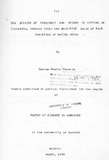| dc.description.abstract | The effects of six-, eight-and ten-weeks cutting interval* and 0, 10 and 20 cm cutting heights and their combinations on tillering, herbage yield, crude protein and in vitro dry matter digestibility of four varieties of napier grass, namely, French Cameroon, Clone 13, Bana and a Bajra x napier hybrid were tested in a deep sandy loam soil of Embu Research Station.
Results from the first seven months of productive life indicated a major difference in the tillering pattern of the four grasses. Regrowth from Bana and Bajra x napier hybrid was dominated by basal and terminal shoots while that from French Cameroon and Clone 13 was dominated by basals and axillary shoots (tillers). The Hybrid napier consistently maintained the highest number of basal and terminal shoots.
Herbage yield (dry matter basis) responded linearly to the length of the cutting interval. Varieties French Cameroon, Bana and Hybrid napier outyielded Clone 13 but the overall yield range was narrow (7.4 - 9.4 t/ha).
Hybrid napier maintained superiority in crude protein content over the other three varieties throughout the duration of the study with a mean crude protein content of 15.46% as opposed to 12.73% in French Cameroon (lowest). The overall mean crude protein content dropped
from 14. 58% to 12. VI % when the cutting interval was increased from six to ten weeks.
Hybrid napier had a consistently lower _in vitro dry matter digestibility (D-value) than the other three varieties. The range of b-values between French Cameroon, Clone 13 and Bana was extremely narrow at each defoliation. The effect of cutting interval on the D-value was inconsistent, initially assuming a negative relationship but subsequently showing a quadratic trend. Cutting height had no significant effect on the dry matter yield, crude protein content or D-value.
The results of this study indicated that within the range of cutting intervals and heights tested, herbage yield was a more appropriate criterion for choice of variety than crude protein content and D-value. They also indicated that so long as sufficient time for regrowth was allowed, cutting height was not a limiting factor to herbage yield. Visual observation however indicated a gradual weakening of the stand frequently defoliated (every six weeks) at the ground level. | |

